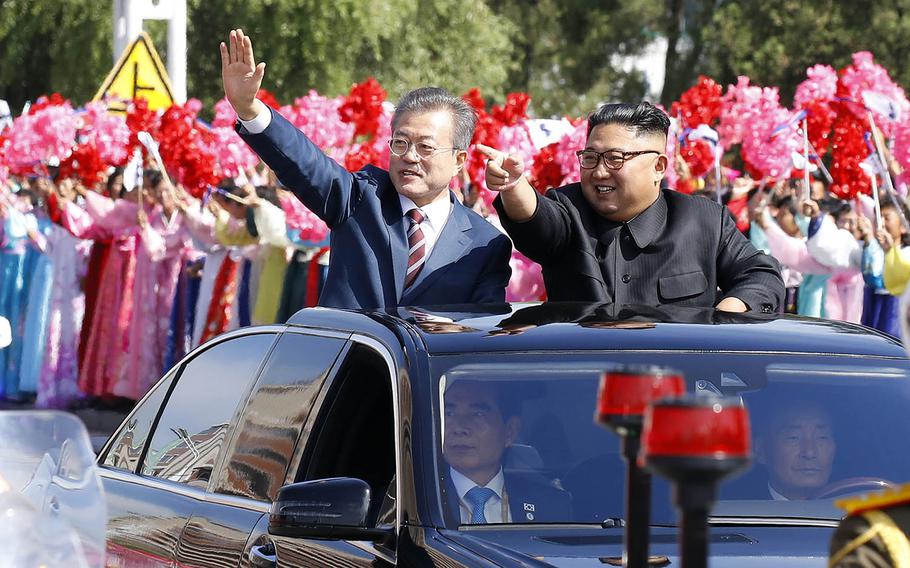
A vehicle carrying South Korean President Moon Jae-in, left, and North Korean leader Kim Jong Un makes its way through Pyongyang, North Korea, Tuesday, Sept. 18, 2018. (Courtesy of Pyeongyang Press Corps)
SEOUL, South Korea — The following are highlights from the inter-Korean military agreement signed by senior defense officials from both countries during the Sept. 18-20 summit between South Korea President Moon Jae-in and North Korean leader Kim Jong Un in Pyongyang.
The source is an English translation provided by the South Korean president’s office.
1) South and North Korea agreed to completely cease all hostile acts against each other in every domain, including land, air and sea that are the source of military tension and conflict.
The two sides agreed to cease various military exercises aimed at each other along the Military Demarcation Line from November 1, 2018.
On the ground, the two sides agreed to cease all live-fire artillery drills and field training exercises at the regiment level and above within 5 kilometers (3 miles) from the MDL.
At sea, the two sides agreed to cease all live-fire and maritime maneuver exercises within the zone north of Deojeok-do and south of Cho-do in the West Sea, and within the zone north of Sokcho and south of Tongcheon in the East Sea.
The two sides also agreed to install covers on the barrels of coastal artilleries and ship guns and close all gunports within the zones.
In the air the two sides agreed to ban tactical live-fire drills involving fixed-wing aircraft, including the firing of air-to-ground guided weapons within the designated No Fly Zones in the eastern and western regions of the MDL.
The two sides agreed to designate No Fly Zones for all aircraft types above the MDL, effective from Nov. 1 in the following way:
For fixed-wing aircraft, No Fly Zones will be designated within 40 kilometers (25 miles) from the MDL in the east … and within 20 kilometers (13 miles) from the MDL in the west.
Other No Fly Zones will be designated in the following way — for rotary-wing aircraft, within 10 kilometers (7 miles) from the MDL; for unmanned aerial vehicles within 15 kilometers (10 miles) from the MDL in the east and 10 kilometers (7 miles) from the MDL in the west for hot-air balloons within 25 kilometers (16 miles) from the MDL.
However, when the employment of aircraft becomes necessary such as in the cases involving firefighting, ground and maritime rescue, medical evacuation, weather observation and farming support, aircraft will be permitted to fly subject to prior notification to the other side. Th No Fly Zones mentioned above do not apply to commercial aircraft (including cargo planes.)
The two sides agreed to take measures to prevent any accidental military clashes at all times in every domain, including land, air and sea.
The two sides agreed to solve all military issues through peaceful consultations by maintaining permanent communication channels in order to prevent at all times any accidental military clash in every domain, including land, air and sea, and by immediately notifying each other when an abnormal situation arises.
2) South and North Korea agreed to devise substantive military measures to transform the Demilitarized Zone into a peace zone.
The two sides agreed to completely withdraw all guard posts that lie within one kilometer (half-mile) of each other as a preliminary measure to withdrawing all GPs within the DMZ.
The two sides agreed to demilitarize the Joint Security Area.
The two sides agreed to proceed with a pilot project of an inter-Korean joint operation to recover remains within the DMZ.
3) South and North Korea agreed to take military measures to prevent accidental military clashes and ensure safe fishing activities by turning the area around the Northern Limit Line in the West Sea into a maritime peace zone.
The two sides agreed to devise military assurance measures for the shared use of the Han River (Imjin River) Estuary.
4) South and North Korea agreed to devise military assurance measures necessary for invigorating exchanges, cooperation, contacts and visits.
5) South and North Korea agreed to devise various measures for mutual military confidence building.
6) This agreement is effective from the date of exchange of the signed documents, following the procedures required for ratification from each party.